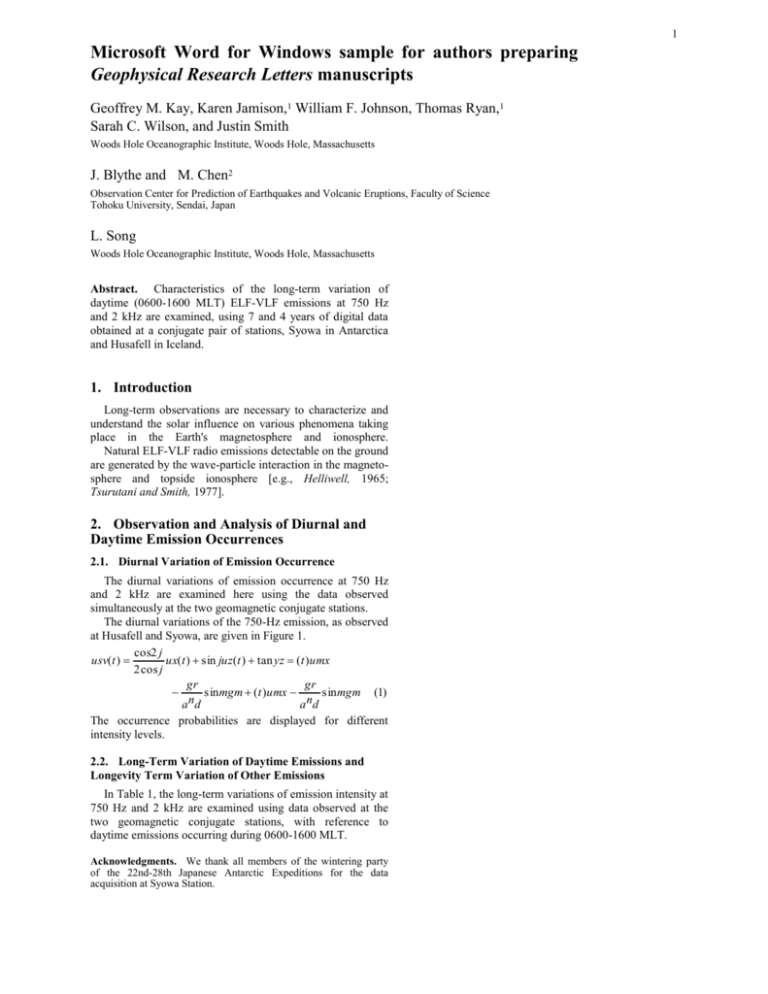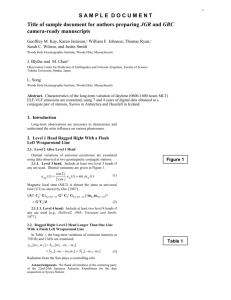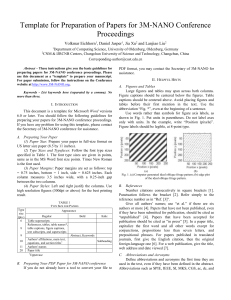GRL
advertisement

1 Microsoft Word for Windows sample for authors preparing Geophysical Research Letters manuscripts Geoffrey M. Kay, Karen Jamison,1 William F. Johnson, Thomas Ryan,1 Sarah C. Wilson, and Justin Smith Woods Hole Oceanographic Institute, Woods Hole, Massachusetts J. Blythe and M. Chen2 Observation Center for Prediction of Earthquakes and Volcanic Eruptions, Faculty of Science Tohoku University, Sendai, Japan L. Song Woods Hole Oceanographic Institute, Woods Hole, Massachusetts Abstract. Characteristics of the long-term variation of daytime (0600-1600 MLT) ELF-VLF emissions at 750 Hz and 2 kHz are examined, using 7 and 4 years of digital data obtained at a conjugate pair of stations, Syowa in Antarctica and Husafell in Iceland. 1. Introduction Long-term observations are necessary to characterize and understand the solar influence on various phenomena taking place in the Earth's magnetosphere and ionosphere. Natural ELF-VLF radio emissions detectable on the ground are generated by the wave-particle interaction in the magnetosphere and topside ionosphere [e.g., Helliwell, 1965; Tsurutani and Smith, 1977]. 2. Observation and Analysis of Diurnal and Daytime Emission Occurrences 2.1. Diurnal Variation of Emission Occurrence The diurnal variations of emission occurrence at 750 Hz and 2 kHz are examined here using the data observed simultaneously at the two geomagnetic conjugate stations. The diurnal variations of the 750-Hz emission, as observed at Husafell and Syowa, are given in Figure 1. cos2 j usv(t ) ux(t ) sin juz(t ) tan yz (t )umx 2 cos j gr gr sin mgm (t )umx sin mgm (1) n a d a nd The occurrence probabilities are displayed for different intensity levels. 2.2. Long-Term Variation of Daytime Emissions and Longevity Term Variation of Other Emissions In Table 1, the long-term variations of emission intensity at 750 Hz and 2 kHz are examined using data observed at the two geomagnetic conjugate stations, with reference to daytime emissions occurring during 0600-1600 MLT. Acknowledgments. We thank all members of the wintering party of the 22nd-28th Japanese Antarctic Expeditions for the data acquisition at Syowa Station. 2 References Belt, E. S., Post-Acadian rifts and related facies, eastern Canada, in Studies in Appalachian Geology, edited by E. Zen et al., pp. 95-113, John Wiley, New York, 1968. Boatwright, J., Detailed spectral analysis of two small New York State earthquakes, Bull. Seismol. Soc. Am., 68, 1117-1131, 1978. Fetterer, F., D. Gineris, C. Johnson, Remote sensing aids in sea-ice analysis, Eos Trans. AGU, 74, 265, 267-268, 1993. Orringer, O., Frontal analysis program, Rep. ASRL TR 1023, Aeroelastic and Struct. Lab., Mass Inst. of Technol., Cambridge, 1974. J. Blythe, M. Chen, K. Jamison, and T. Ryan, Observation Center for Prediction of Earthquakes and Volcanic Eruptions, Faculty of Science, Tohoku University, Sendai, Japan. W. F. Johnson, G. M. Kay, J. Smith, L. Song, and S. C. Wilson, Department of Geology and Geophysics, Woods Hole Oceanographic Institution, Woods Hole, MA 02543. (e-mail: kj, wj, gk, js, ls, or sw@red.whoi.edu) (Received October 6, 1996; revised February 27, 1997; accepted March 31, 1997.) 1Now at Observation Center for Prediction of Earthquakes and Volcanic Eruptions, Faculty of Science, Tohoku University, Sendai, Japan. 2Also at National Institute of Polar Research, Tokyo, Japan. KAY ET AL.: SAMPLE FOR AUTHORS PREPARING MANUSCRIPTS KAY ET AL.: SAMPLE FOR AUTHORS PREPARING MANUSCRIPTS KAY ET AL.: SAMPLE FOR AUTHORS PREPARING MANUSCRIPTS Figure 1. Figure or plate captions consist of a paragraph containing several sentences. Captions must be set at both 8.4 cm (3.3 inches, 20 picas) and 17.3 cm (6.8 inches, 41 picas) wide. Figure 1. Figure or plate captions consist of a paragraph containing several sentences. Captions must be set at both 8.4 cm (3.3 inches, 20 picas) and 17.3 cm (6.8 inches, 41 picas) wide. Figure 1. Figure or plate captions consist of a paragraph containing several sentences. Captions must be set at both 8.4 cm (3.3 inches, 20 picas) and 17.3 cm (6.8 inches, 41 picas) wide. Figure or plate captions consist of a paragraph containing several sentences. Captions must be set at both 8.4 cm (3.3 inches, 20 picas) and 17.3 cm (6.8 inches, 41 picas) wide. Figure or plate captions consist of a paragraph containing several sentences. Captions must be set at both 8.4 cm (3.3 inches, 20 picas) and 17.3 cm (6.8 inches, 41 picas) wide. Table 1. Linear Representation of Emission Intensity Wm Month a 2 kHz* b Correlation Coefficient June -0.71 2.97 (0.99) September -0.64 2.95 (0.97) December -0.67 2.79 (0.99) 750 kHz* June -0.67 2.33 (0.92) September -0.55 2.17 (0.99) December -0.58 1.92 (0.99) Here log Wm = am + b. * G model averaged for study regions 0300, 1100, and 1700 UT and 0600-1600 MLT. 3 Figure 2. This is a broadside caption, which must fit within 24 cm (9.5 inches, 57 picas). Set the left and right margins at 0.75 inch for the maximum width allowed for a broadside caption. Make sure that the font size is 9.7 CG Times and that the line spacing is 0.94 inch to match AGU caption style. Turn justification on, and do not forget to put the word "Figure" or "Plate" and a period in bold, with two spaces between the period and the beginning of the caption text.






